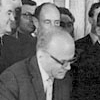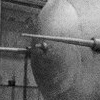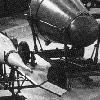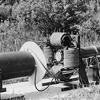Nuclear Testing & Conscience: 1957-1963
In 1957, Kurchatov asked Sakharov to write an article denouncing the new American military development of a so-called “clean bomb” that would leave less radioactive debris. Sakharov took the matter more seriously than a mere propaganda exercise. Some Western activists had begun to warn about the dangers of radioactive fallout from any nuclear explosion. Passionate debate was under way in the United States and elsewhere. Using available biological data, Sakharov calculated that detonation of a one-megaton “clean” H-bomb would produce enough radioactive carbon to have long-lasting global effects, resulting in 6,600 deaths worldwide over the next 8,000 years.
Sakharov’s papers, “Radioactive Carbon from Nuclear Explosions and Nonthreshold Biological Effects,” and “The Radioactive Danger of Nuclear Tests,” disputed the soothing conclusions of the American weapons specialist Edward Teller, as well as most of his Soviet colleagues, who argued that tests of nuclear weapons were practically safe. For Sakharov, the death toll from nuclear testing in the atmosphere – however small compared to deaths from other causes – was simply a fact proved by science, with inescapable moral consequences.
“The remote consequences of radioactive carbon do not mitigate the moral responsibility for future victims. Only an extreme lack of imagination can let one ignore suffering that occurs out of sight. The conscience of the modern scientist must not make distinctions between the suffering of his contemporaries and the suffering of generations yet unborn.”
By raising the question: “What moral and political conclusions must be made from these numbers?” Sakharov went beyond the boundaries of the discipline of physics and accepted a role of greater responsibility. He considered this paper as the starting point for his growing social awareness. It was published in 1958 shortly after the Soviet Union announced a temporary moratorium on nuclear tests.
The turning phase in the career of Sakharov the weapon designer were the years 1961-63. In July 1961 the Soviet leader Nikita Khrushchev decided to revoke the moratorium on bomb tests, announcing his decision at a specially convened meeting at the Kremlin. Sakharov was the only one who openly objected that a renewal of testing would yield little technically while damaging international security. But obeying the order from the head of state, he took part in the preparations for testing. Sakharov trusted Khrushchev – trusted too much – because of the politician’s exposure of Stalin’s crimes, his mass rehabilitation of the victims of the Terror, a general cultural “thaw,” and the call for peaceful coexistence with the West at the Twentieth Party Congress in 1956.
The so-called Tsar Bomb was developed under Sakharov and tested on October 30, 1961. It was the most powerful device ever exploded on Earth.Sakharov’s illusory world cracked the next year, 1962 when he learned “the most terrible lesson” – he desperately tried but failed to prevent another bomb test, which was unnecessary from the technical point of view but still produced deadly fallout. (For more information visit Sakharov's World as a Weapons Maker)
“A terrible crime had been committed, and I couldn’t prevent it! A feeling of impotence, unbearable bitterness, shame and humiliation overcame me. I dropped my face on the table and wept. This was probably the most terrible lesson of my life: you can’t sit on two chairs.”
The Soviet “military-industrial complex” (similar to what President Eisenhower had warned Americans against in his farewell address of January 1961) had defeated Sakharov in September 1962. He could no longer think that there was something important he did not know about foreign policy or how capitalists conduct negotiations. This was all domestic, internal, technical, all under his nose. His understanding of his personal responsibility became even stronger.
He put this understanding to work in facilitating the 1963 Moscow Ban on Testing.
Concluding a real international treaty was a difficult process delayed by mutual distrust. Sakharov’s scientific estimates of radioactive hazards, and his moral convictions, led him to continuing efforts to push the Soviet leadership to stop atmospheric nuclear tests. He finally succeeded in convincing them to accept an American proposal for a limited ban. The 1963 Test-Ban Treaty, signed in Moscow by the US, the USSR, and the United Kingdom, banned all nuclear weapons tests in the atmosphere, in outer space and underwater, but allowed the tests to continue underground.
“I consider the Moscow Treaty of historic significance. It has saved the lives of hundreds of thousands, possibly millions, of people who would have perished had testing continued. And perhaps even more important, the treaty was a step toward reducing the risk of thermonuclear war. I am proud of my contribution to the Moscow Treaty.”
Anticipating that similar situations may arise again, Sakharov decided to remain at the weapons design installation a while longer: “I still believed that my presence at the Installation could at some crisis point be decisively important,” he recalled, “and this was one of the reasons I didn’t leave... But from the fall of 1963, I began to work seriously on pure science as well.”






